When it comes to employee benefits, vacation time is one of the most valued perks. However, many employees may not fully understand how PTO accrual rules work and how to calculate earned vacation time correctly. As for employees, most of them only check out their company’s vacation accrual policy when they’re about to vacation.
In fact, your vacation accrual policy can affect everything from how soon an employee can take their vacation to how much money they get paid while on a day off.
In this blog post, we’ll break down the concept of vacation accrual rules and their importance, and provide a simple guide on making respective calculations (though you can use our free vacation hours calculator at any moment).
What Is Vacation Accrual?
Vacation accrual (or leave accrual) is the process by which employees earn paid time off (PTO) for vacation days over time.
Instead of receiving a lump sum of vacation days at the beginning of the year, employees typically accrue vacation hours based on the number of hours they work.
This system allows employees to build up their vacation time gradually, ensuring they have the opportunity to take time off while still being compensated for their work.
Why Is Vacation Accrual Important?
Vacation time is essential for maintaining a healthy work-life balance. It allows employees to recharge, reduce stress, and improve productivity.
Companies that offer generous vacation policies often see higher employee satisfaction and retention rates. Employees feel valued when they know they can take time off without financial repercussions.
In some regions, laws govern how vacation time is accrued and utilized. Understanding these regulations helps employers stay compliant and avoid legal issues.
Most Common Vacation Accrual Rules
Vacation accrual rules dictate how employees earn and accumulate vacation days over time. These rules can vary widely between organizations, but they generally fall into a few common categories:
1. Accrual rate.
The vacation accrual rate is the pace at which employees earn vacation time as they work. Typically expressed in hours earned per pay period, this rate allows employees to gradually accumulate time off throughout their employment.
The specific rate can vary based on factors like the company’s policies, the employee’s position, length of service, or employment status (full-time versus part-time). This mechanism allows for a fair and systematic approach to granting vacation time, encouraging work-life balance and employee satisfaction.
For example:
A new employee might accrue vacation at a rate of 1.25 days per month, which translates to 15 days per year. In contrast, employees with over five years of service may receive an enhanced accrual rate, accumulating 1.67 days per month, or 20 days annually.
2. Accrual method.
Front-loaded: Some companies provide a lump sum of vacation days at the beginning of the year. This method allows employees to use their vacation time as soon as it’s granted.
Hourly accrual: Others may calculate vacation time based on hours worked. For instance, an employee might earn one hour of vacation for every 40 hours worked.
Annual accrual: Some organizations may offer a specific number of days per year, which can be accrued over time.
3. Accrual period.
A vacation accrual period refers to the timeframe over which employees accumulate vacation time that they can later use for time off from work.
For example:
Monthly: Employees accrue a set number of vacation hours or days at the end of each month. For instance, accruing 1.25 days per month to reach 15 days annually.
Bi-weekly: In line with bi-weekly pay periods, employees earn a portion of their annual vacation time every two weeks. This might look like accruing 4 hours per pay period for full-time employees.
Yearly: Some organizations grant the entire year’s vacation balance at the beginning of each calendar or fiscal year, or on the employee’s work anniversary.
Hourly: Particularly in part-time or varying schedules, vacation time accrues based on the actual hours worked, such as 1 hour of vacation for every 40 hours worked (or 0.025 leave hours per hour worked).
4. Carryover policies.
Vacation carryover refers to the policy that allows employees to transfer unused vacation time from one year to the next. This provides flexibility and ensures that workers do not lose their hard-earned leave if they cannot take it within a calendar year.
Vacation expiration, on the other hand, is a rule stipulating that if the carried-over vacation time is not used within a certain period, typically by the end of the subsequent year, it is forfeited.
For example:
If an employee has a total of 20 vacation days and only uses 15 in a given year, they can carry over the remaining 5 days into the next year, subject to company limits. Or in case, vacation carryover is not allowed by the company’s policy, the remaining 5 days will simply expire.
5. Cap on accrual.
A leave balance cap refers to the maximum amount of leave time, such as vacation or sick leave, that an employee can accumulate or carry over during a specific period. Once an employee reaches this cap, they stop accruing additional leave until they use some of their stored time.
This rule encourages employees to use their leave time rather than hoarding it. Thus, it promotes a healthier work-life balance and maximizes the benefits of time off.
For example:
A company might set a cap of 30 days for accrued annual leave, meaning employees cannot accumulate more than 30 days of annual leave. Similarly, for sick leave, a common cap might be 15 days, beyond which unused sick leave doesn’t accumulate from year to year.
6. Waiting period for vacation accrual.
The waiting period for vacation accrual is the time between an employee’s hire date and when they become eligible to start accruing vacation days. This waiting period is typically 90 days but can vary from company to company.
For example:
If you start working for a company on January 1, you would be eligible to start accruing vacation days on April 1.
7. Payout upon termination.
A vacation payout upon termination refers to the financial compensation an employee receives for the unused vacation time they have accrued at the time of their departure from a company. This policy varies by country and company, but in general, it’s a common practice to compensate departing employees for the vacation time they earned but did not use.
The specifics of how this payout is calculated, including any caps or limits, depend on the terms of the employment contract and local labor laws.
For example:
In California, employers are required to pay out any accrued but unused vacation time as part of the employee’s final paycheck upon termination because it’s considered a part of the earned wages.
8. Prorated vacation time.
Since part-time and full-time employees work a disparate amount of time per week, they earn vacation time differently as well. That’s where the concept of pro-rata leave comes into action.
Prorating vacation time means allocating it to employees in line with the portion of time they’ve worked in a company.
You can do so not only for part-time employees but also for full-time workers who have joined your team in the middle of the year and can’t get the same lump-sum vacation entitlements that your other full-time workers have received at the beginning of the year.
For example:
Let’s say you grant 20 days off per year to full-time employees on January 1 each year, and a new team member has joined your company on March 17.
Here’s what you have to so:
Step 1: Subtract the number of days the new employee had missed from the overall number of workdays within the year:
Step 2: Pro-rate their vacation time using this formula:
Step 3: Round up the calculations (e.g., till 16 days off).
9. Tenure- or performance-based increases.
In many organizations, especially public ones, it is normal to increase time off entitlements based on the number of years their team members have been employed. In some cases, it also makes sense to increase vacation accrual rates based on employees’ professional achievements and the role they play within the organization.
This way, higher annual vacation allowance becomes a reward either for one’s commitment to the workplace or their direct contribution to business growth and development.
For example:
On average, US employees in the private sector receive 15 days off a year after 5 years of work, and 20 days off after 20 years of work (Source).
10. Accrual rules by leave type.
Unless you have unlimited vacation policy in your company or simply don’t care about tracking why employees go absent, you can develop different accrual rules to different types of leave. This includes the method of accrual, the rates applied, and so on.
For example:
You can accrue annual vacation time at the rate of 2 days off per month and cancel unused vacation days on December 31 each year. In addition to that, you can preload employees’ leave balances with 2 duvet days per annum and allow them to carry over this benefit from year to year, accumulating it without any limitations.

How Do Vacation Accrual Rules Work?
Step 1: Determine accrual rates.
The accrual rate can be expressed in hours or days and is often based on the employee’s length of service or hours worked.
Example:
Hourly employees: An employee might accrue 1 hour of vacation for every 40 hours worked. Then, their accrual rate equals 0,025:
Salaried employees: Provide a set number of vacation days per year (e.g., 15 days) and then convert it into hours if necessary (e.g., 15 days x 8 hours = 120 hours). Based on these numbers, their accrual rate is 0,057:
Step 2: Calculate the overall vacation time.
Use the following formula to calculate the earned vacation:
For instance, if an employee works 1,600 hours in a year and accrues 1 hour of vacation for every 40 hours worked, they will earn 40 vacation hours:
Step 3: Track vacation usage.
Let’s suppose an employee has earned 40 vacation hours and took one day off. To keep their leave balance up to date, subtract the used time off from the overall earned vacation time like so:
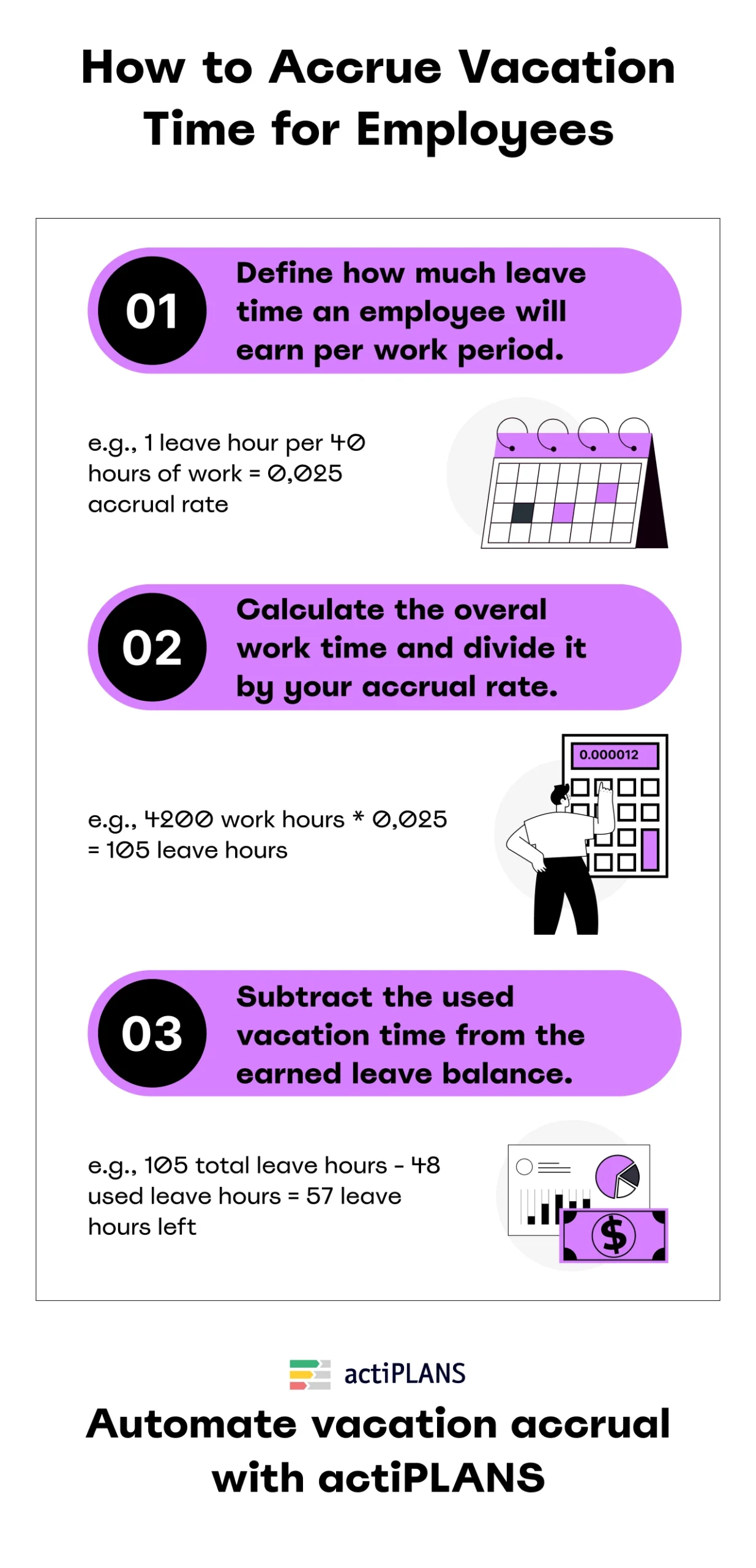
A Few More Examples…
Calculating vacation accrual for hourly employees
An hourly employee gets one hour of vacation time for every 30 hours worked. The employee has 990 hours worked and 12 hours of PTO spent. The task is to calculate the current PTO amounts.
- Divide the total number of hours worked by 30: 990 / 30. The employee has earned 33 hours of vacation time.
- As long as they’ve already spent 12 leave hours, we must subtract them from the total number of earned PTO hours: 33 – 12 = 21.
- The hourly worker has 21 vacation hours remaining.
Calculating vacation accrual for full-time employees
Let’s say a full-time employee gets three days of vacation every month. The employee has been working for nine months and two weeks and took five days off. What is their current PTO balance?
- Three days of monthly vacation for nine months means 3 * 9 = 27 PTO days.
- They also have half a month of worked time, meaning 3 / 2 = 1,5 more PTO days.
- The total number of accrued PTO days: 27 + 1,5 = 28,5 PTO days.
- As long as they’ve already spent 5 leave days, we must subtract this amount from the total PTO days earned: 28,5 – 5 = 23,5.
- This full-time employee has 23,5 vacation hours remaining.
Main Types of Vacation Accrual Policies
Equal vs. progressive leave time policy
Leave time can be accrued in equal amounts every year or progressively – depending on the years of employment. With an equal leave policy, everyone gets the same amount of time off, regardless of how long they’ve been with the company.
On the other hand, a progressive leave policy gives employees more time off as they stay with the company longer. This is often seen as a way to encourage employee loyalty and longevity.
Separate vs. combined leave time policy
A separate leave policy is when an organization has two types of time off balances, one for vacation and one for sick days. In contrast, a combined leave policy is when an organization has one type of leave time that can be used for both vacation and sick days.
The accrual rate is the main difference between a separate and a combined leave policy. Employees accrue vacation and sick time at different rates with a separate policy. For example, an employee might earn two weeks of vacation per year but only four days of sick time. This can be confusing and difficult to keep track of.
Employees accrue vacation and sick time at the same rate with a combined policy. For example, an employee might earn one day of vacation and one day of sick time per month. This makes it easier to keep track of and use your leave time.
Limited vs. unlimited time off policy
There are no such things as vacation tracking and leave requests when you have an unlimited time off policy! You can take off whenever you want, for as long as you want – no questions asked (as long as you meet the set deadlines, complete your tasks successfully, and show good work performance overall).
As for the limited time off policy, it is a little more restrictive and provides you with a certain number of vacation days per year. If you want to take more time off than it’s allowed, you’ll need to get approval from your boss first.
Time off in lieu policy (TOIL)
The TOIL policy is a way of compensating employees for working overtime. Under this policy, employees are given an additional hour off for each extra hour they invest in work, up to a specific limit. This allows them to take time off later rather than being paid overtime wages.
There are several benefits of having a TOIL policy in place. First, it helps to encourage employee productivity by giving them an incentive to work extra hours. Second, it helps to prevent burnout by allowing employees to take regular breaks from work. Finally, it can help to reduce labor costs by avoiding the need to pay overtime wages.
Use-it-or-lose-it vs. carry-over policy
The use-it-or-lost-it vacation policy states that if you don’t use all of your vacation days within a specific time frame, you will lose them. It is designed to encourage employees to take their vacation days and prevent them from accruing too many unused vacation days.
On the other hand, a carry-over policy allows employees to roll unused vacation days over to the following year. This way, your staff members don’t have to feel pressured to use all their days off in one year and can collect considerable leave time for a long-term vacation.
There are pros and cons to both types of policies. With a use-it-or-lose-it policy, employees may be more likely to take all of their vacation days and not let any go to waste. This can be good for their mental health and well-being. However, this policy can also be stressful if your team has a busy year and can’t manage to take all of the earned vacation days.
A carry-over policy gives staff members more flexibility, but it also means they may not take all their vacation days in a given year. This could lead to accruing too many vacation days and eventually losing them.
Simplify the Process with Vacation Time Calculator
It is important to keep track of used and unused vacations accurately to avoid misunderstanding and workplace conflicts.
Some companies prefer the old-fashioned way, with spreadsheets and paper requests. This consumes valuable time that could be spent doing actual work.
Our automated vacation hours calculator is a much better solution – it streamlines the vacation accrual process in line with your rules and produces error-free results.
Managing Vacation Accrual Rules With Ease
As your organization evolves, so do its vacation accrual rules. Implementing and changing these rules can be a daunting task, but a vacation tracking solution can simplify the process significantly.
Once you have a tool in place, you can focus on more important things, knowing that your employees’ vacation balances are taken care of.
When selecting a tool for automated vacation accrual, there are a few things you should definitely keep in mind:
- Flexibility
- Simple leave management procedure
- Compatibility with multiple devices
- Rich data review options
- Precise time off calculations
Of course, finding a leave tracker that meets all these requirements may be challenging. However, we know one excellent solution that does just that!
Try actiPLANS!
actiPLANS offers a smooth way of time off calculation and leave request management. You can tune it in line with your unique vacation accrual rules and then keep all data on employees’ leave balances at a glance and up to date.
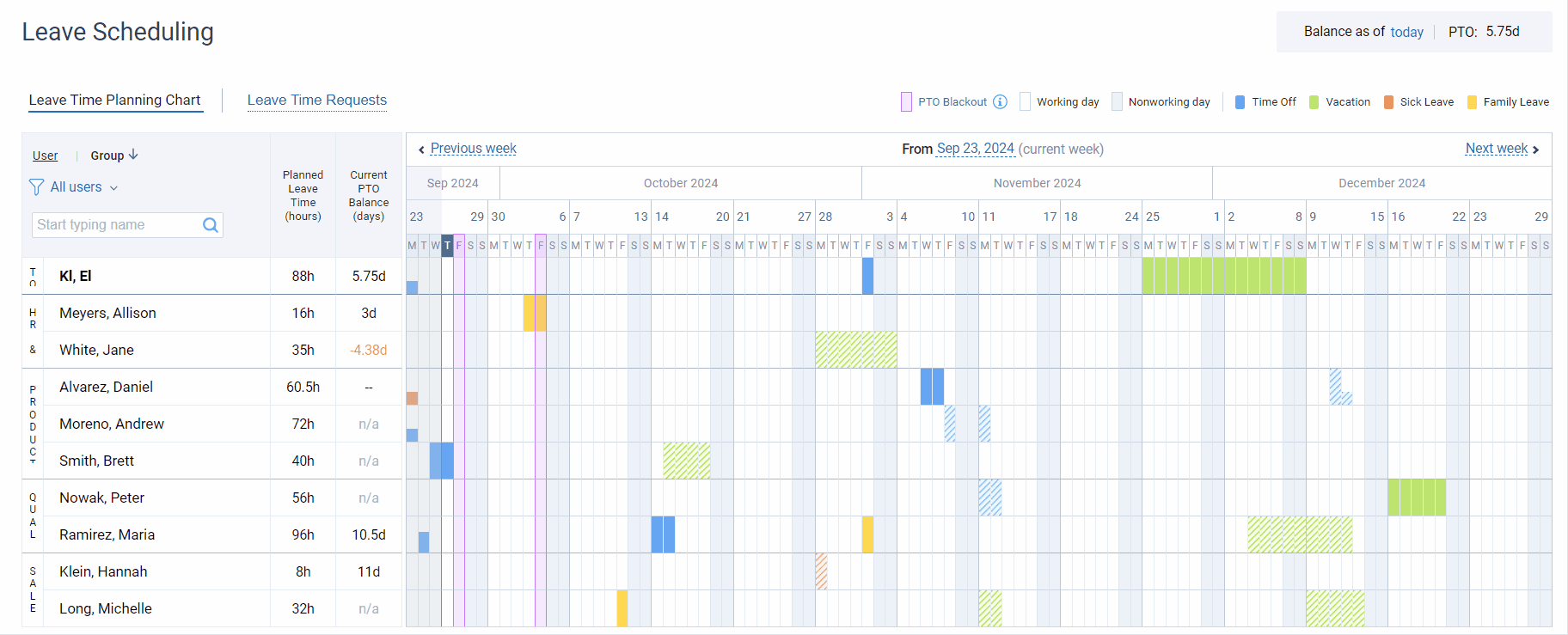
actiPLANS lets you create and track unlimited leave types, set individual accrual rates for them, and distinguish between the PTO and sick leave balances.
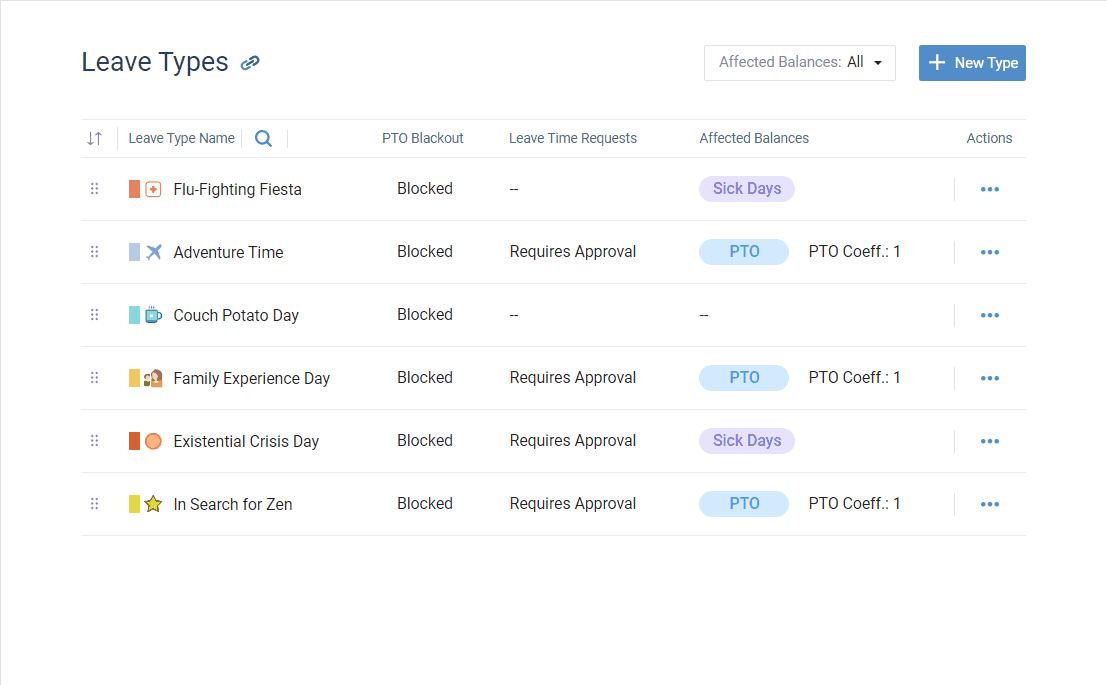
When it comes to vacation accrual rules, you can define the accrual rate, which determines how much vacation time employees earn based on their length of service or other criteria. This rate can be set in hours, days, or any other unit of measurement.
It’s also possible to configure the accrual period, such as weekly, bi-weekly, monthly, or annually. This determines the frequency at which employees earn vacation time.
You can also set vacation carryover and expiration rules based on the organization’s policies.
Besides that, the system allows you to manage paid time off (PTO) accruals on a biweekly, monthly, semi-monthly, etc. basis and set an individual PTO accrual period and date for each employee.
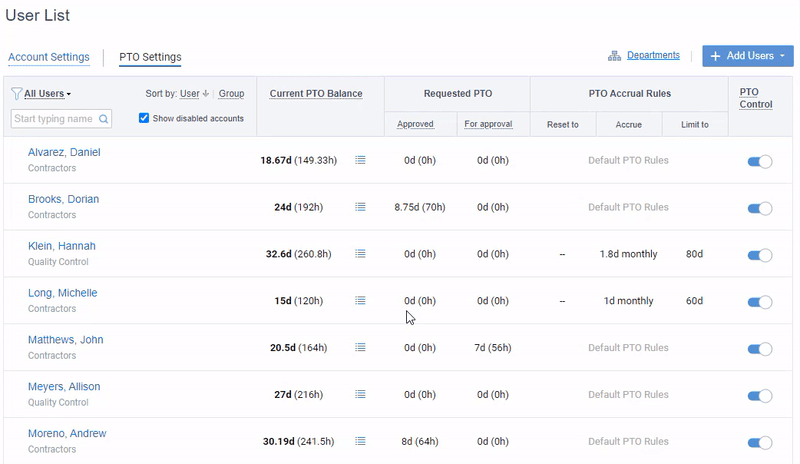
Then, actiPLANS will calculate employees’ vacation balances based on the accrual rate and accrual period, employees will be able to see their available vacation time via personal dashboards, and managers will be able to generate comprehensive staff absence reports.
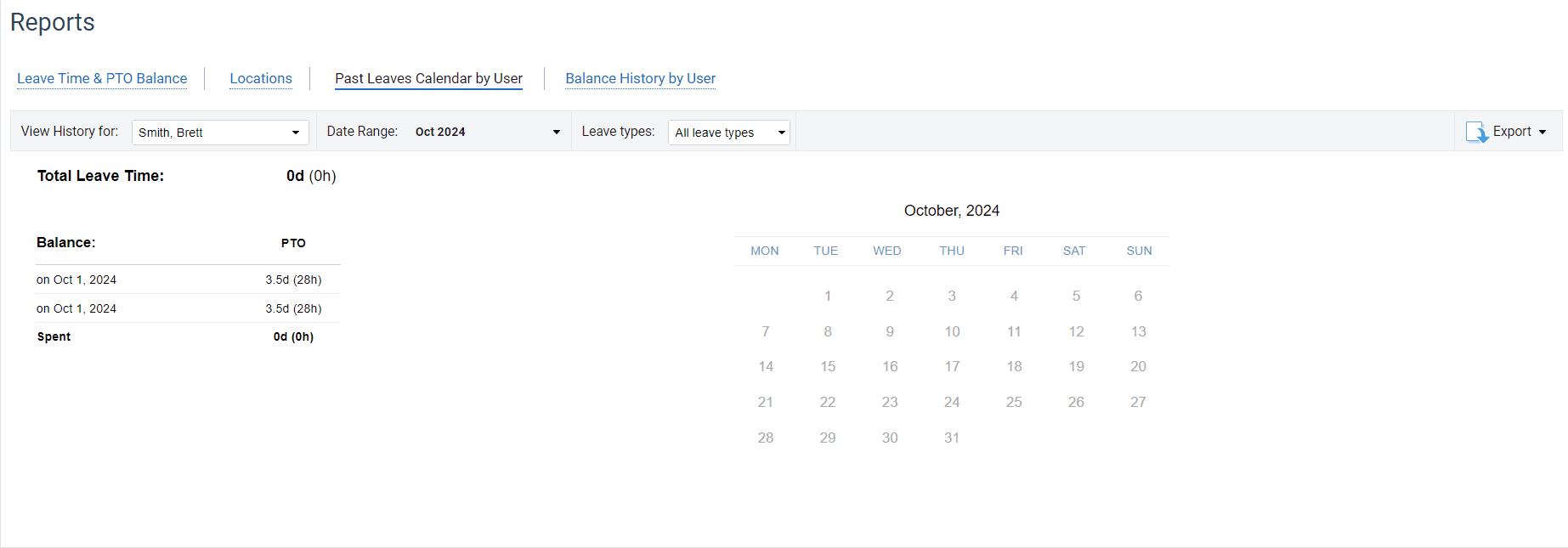
Lastly, you can combine actiPLANS’ vacation accrual functionality with overtime tracking in actiTIME to easily convert the extra hours worked in TOIL.
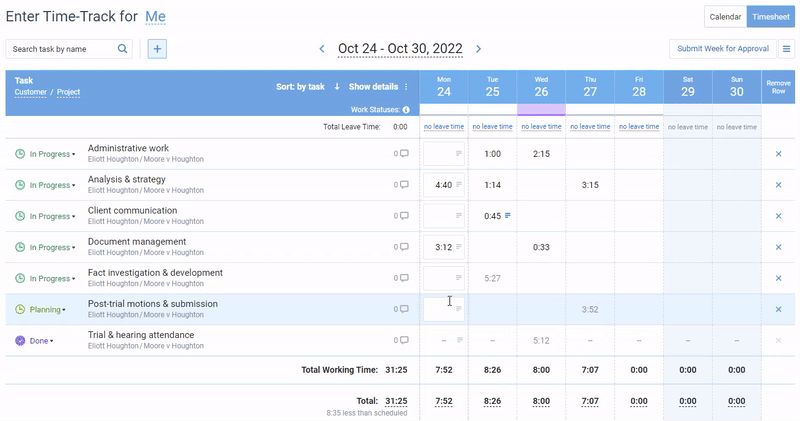
Ready to check actiPLANS out in action yourself? Sign up for a free 30-day trial and see how effortless vacation accrual can be.




